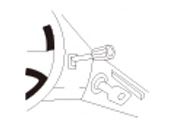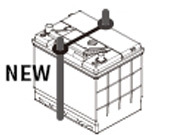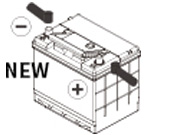Technical Information
we provide various information about basic knowledge about batteries and how to use/handle them to help you manage your batteries more efficiently. For any questions about the provided information below, please contact us at anytime.
Battery Maintenance
How to handle battery
Precaution
If treated with care and taking the proper precautions, lead acid batteries can be handled safely with minimum risk.
However, lead acid batteries contain sulfuric acid which is both poisonous and corrosive.
This makes them potentially hazardous and can cause serious injury when standard handling procedures and safety measures are not respected.
-

No sparks,
flames or Smoking. -

Shield eyes.
-

Keep
children away. -

Corrosive hazard.
-

Explosion hazard.
-

Read instruction
manual carefully. -

Flush eyes
immediately with water.
Get medical help fast.
Safety
- Always wear acid resistant clothing, protective goggles, PVC gloves and rubber boots.
- Avoid smoking, sparks and flames near operating or charging lead acid batteries.
- Keep metal objects away from terminals.
- Batteries are heavy. Lift carefully and do not place on unstable surfaces.
Emergency Action
- Splashes in eyes : Wash out the eye with plenty of water for at least 15 minutes.
- Splashes on skin : Remove contaminated clothing carefully and wash the affected skin areas with plenty of water.
- Swallowed : Drink copious amounts of milk of magnesia, water or milk. Do not induce vomiting.
Storage
- Keep batteries upright.
- Never stack over 4 layers.
- Batteries should not be directly exposed to the sun.
- Never drop, never overthrow.
- Keep batteries clean and always store in a cool, dry place.
- In all cases, (First in, First Out) storage procedure should be applied.
- 5 Year
- A MFG. Month
- K Country
- J MFG. Factory
- 01 Date
- Date Coding System on the Cover
ex)Date Code(MFG. Code) : 5AKJ01 means manufacturing date Jan.01.2015 - Year : 5(2015)
MFG. Month : A(JAN), B(FEB), C(MAR), D(APR), E(MAY), F(JUN), G(JUL), H(AUG), J(SEP), K(OCT), L(NOV), M(DEC)
MFG. Factory : J(Jeonju Plant), D(Daejeon Plant)
Installation and recharging
Installation
-
01
Turn off engine,
all accessories and
key-off.
-
02
Remove the negative
cable (Ground) first,
and then positive
cable from the old
battery.
-
03
Remove the
hold-down bracket
or clamp.
-
04
Replace with new
battery and fix it with hole-down bracket or
clamp.
-
05
Connect cables in
reverse order from
positive to negative
if clamp or cables are corroded,
remove corroded material and
grease it
Recharging
If the battery is below 12.4V or fails to pass the load test, battery must be recharged as soon as possible to prevent lead sulfation. During charge, if the battery sprays electrolyte through the vent holes or gets hot (over 52℃), the charge must be stopped for a time to allow the battery to cool.
Constant current charge method
-
01
Measure the OCV(Open Circuit Voltage)of a discharged battery.
-
02
Set the OCV and capacity of the battery with moderate electric current and time stated below table.
-
03
Connect the battery to constant current charger and start charging.
-
04
When the charging time is completed, separates battery from the charger.
| State of Charge |
Sp.Gr | OCV | ~30Ah | ~40Ah | ~50Ah | ~60Ah | ~70Ah | ~80Ah | ~90Ah | ~100Ah | ~110Ah |
|---|---|---|---|---|---|---|---|---|---|---|---|
| 1.5A | 2.0A | 2.5A | 3.0A | 3.5A | 4.0A | 4.5A | 5.0A | 5.5A | |||
| 100% | 1.265 | 12.7 | - | ||||||||
| 75% | 1.225 | 12.4 | 6Hrs | ||||||||
| 50% | 1.190 | 12.2 | 12Hrs | ||||||||
| 25% | 1.155 | 12.0 | 18Hrs | ||||||||
| Discharge | 1.120 | 11.9 | 24Hrs | ||||||||
Constant voltage charge method
-
01
Connect the discharged battery to constant voltage charger.
-
02
Charge for 24 hours as following voltage upon battery type.
- 12V MF Battery: 16V
- 12V AGM Battery: 14.4V -
03
When the charging time is completed, separates battery from the charger.
Battery testing procedure
Test
Visual check
- Check the Container, Cover and Terminals. Where physical damage is present, replace the battery.
- Check the Indicator (If the battery has the Indicator). Always look right down when viewing the Indicator
and lightly tap the Indicator on the battery to dislodge any air bubbles.

Good Condition

Charging Necessary

Replace Battery
Voltage check
- If OCV is below 12.4V, recharge the battery immediately.
Discharge Test(Load Test)
- Connect the battery tester to battery terminals.
- Measure the temperature of the battery around.
- Set the battery tester ampere values for ½ of the CCA rating.
- Apply the load for 15 seconds and read the voltage.
- Compare measured values with values in TABLE 2.If the values are outside of the table values, recharge the battery and test again.
- If the battery fails the load test twice, replace it.
- Sometimes, electronic testers such as MIDTRONICS, SNAP-ON and etc are used instead of load tester.
- Electronic testers are only suitable for batteries that have been in use for a certain time.
- They cannot rate the performance of new or unused batteries.
- For this reason, ATLASBX recommends the test defined in global standards to confirm rated specifications.
State of Charge
| Approximate State of Charge | OCV |
|---|---|
| 100 % | 12.75 |
| 75 % | 12.40 |
| 50 % | 12.20 |
| 25 % | 12.00 |
| Discharged | 11.90 |
Load Test
| Minimum Voltage | Temperature |
|---|---|
| 9.6V | 21 ℃ above |
| 9.4V | 10 ℃ |
| 9.1V | -1 ℃ |
| 8.9V | -7 ℃ |
| 8.5V | -18 ℃ |
For reference only
